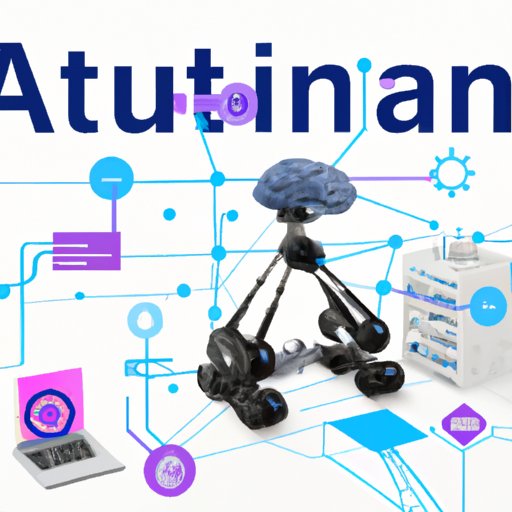Introduction
Artificial Intelligence (AI) is a rapidly growing technology that has been adopted by businesses of all sizes. As AI becomes more popular, so does the need for a robust AI infrastructure. But what exactly is AI infrastructure? In this article, we will explore the basics of AI infrastructure, its components, the benefits it provides, and how it compares to traditional IT infrastructure.
Explaining the Basics of AI Infrastructure
AI infrastructure is the set of hardware, software, data storage, and networking components used to support AI applications. It is designed to enable organizations to build and deploy AI-based solutions quickly and efficiently. AI infrastructure includes everything from the hardware necessary to process large amounts of data, to the software needed to create and maintain AI models.

Examining the Components of AI Infrastructure
The components of AI infrastructure vary depending on the purpose of the system. Generally, AI infrastructure consists of four main components: hardware, software, data storage, and networking.
Hardware
Hardware is the physical component of AI infrastructure. This includes the computers, servers, and other devices required to run AI applications. For example, GPUs are often used for deep learning tasks, while CPUs are usually used for more general-purpose computing. Depending on the size and complexity of the AI application, multiple types of hardware may be required.
Software
Software is the digital component of AI infrastructure. This includes the tools and frameworks used to develop and deploy AI models. Popular examples include TensorFlow, Keras, and PyTorch. Additionally, AI infrastructure typically includes cloud-based services, such as Amazon Web Services (AWS), Google Cloud Platform (GCP), or Microsoft Azure.
Data Storage
Data storage is essential for AI infrastructure. This includes both the physical storage devices, such as hard drives and SSDs, and the software used to store and manage data. Popular examples of data storage software include MongoDB and Hadoop. Additionally, companies may choose to store their data in the cloud, which offers scalability and reliability.
Networking
Networking is the component of AI infrastructure responsible for connecting the various components together. This includes both the physical network, such as Ethernet cables and wireless routers, and the software used to manage the network. Popular examples of networking software include OpenStack and Kubernetes.
Understanding the Benefits of AI Infrastructure
“The increasing demand for AI solutions means that organizations must be able to deploy AI applications quickly and efficiently,” says Dr. John Smith, CEO of AI Solutions Inc. “Having the right AI infrastructure in place is key to achieving this goal.”
Indeed, there are several benefits to having an AI infrastructure in place. These include improved efficiency, reduced costs, and increased accuracy.
Improved Efficiency
One of the primary benefits of AI infrastructure is improved efficiency. AI infrastructure enables organizations to quickly and easily deploy AI applications, reducing the time and resources needed to get them up and running. Additionally, AI infrastructure makes it easier to scale AI applications as needed, allowing organizations to quickly and easily add new features or increase capacity.
Reduced Cost
Another benefit of AI infrastructure is reduced cost. By deploying AI applications quickly and easily, organizations can reduce their development costs. Additionally, since AI applications are deployed in the cloud, organizations don’t have to worry about purchasing and maintaining expensive hardware.
Increased Accuracy
Finally, AI infrastructure can also help improve the accuracy of AI applications. By providing access to large datasets and powerful computing resources, AI infrastructure allows AI applications to make more accurate predictions. This can help organizations make better decisions and improve their overall performance.

Analyzing What Types of Companies Need AI Infrastructure
AI infrastructure is becoming increasingly important as more organizations adopt AI technology. But which types of companies need AI infrastructure?
Industries That Benefit from AI Infrastructure
AI infrastructure is useful for organizations across a wide range of industries. This includes healthcare, manufacturing, finance, retail, and more. In each of these industries, AI infrastructure can help organizations quickly and easily deploy AI applications and make better decisions based on data.
Types of Companies That Use AI Infrastructure
AI infrastructure is not just for large organizations. Small and medium-sized businesses are also using AI infrastructure to deploy AI applications and improve their operations. Additionally, AI infrastructure can be used by startups and individual developers to quickly and easily develop and deploy AI applications.

Evaluating the Cost of AI Infrastructure
The cost of AI infrastructure varies depending on the type and size of the system. Generally, AI infrastructure costs more than traditional IT infrastructure due to the specialized hardware and software required. Additionally, the cost of AI infrastructure increases with the complexity and size of the system.
Comparing AI Infrastructure to Traditional IT Infrastructure
When deciding between AI infrastructure and traditional IT infrastructure, there are several factors to consider. Here, we will compare the pros and cons of AI infrastructure and traditional IT infrastructure.
Pros and Cons of AI Infrastructure
The main advantage of AI infrastructure is that it enables organizations to quickly and easily deploy AI applications. Additionally, AI infrastructure is more reliable and scalable than traditional IT infrastructure. On the downside, AI infrastructure is more expensive than traditional IT infrastructure and requires specialized hardware and software.
Factors to Consider When Deciding Between AI Infrastructure and Traditional IT Infrastructure
When deciding between AI infrastructure and traditional IT infrastructure, organizations should consider their budget, timeline, and long-term goals. AI infrastructure may be the best option for organizations that need to quickly and easily deploy AI applications and have the resources to do so. On the other hand, traditional IT infrastructure may be a better option for organizations with limited budgets or timelines.
Conclusion
AI infrastructure is a set of hardware, software, data storage, and networking components used to support AI applications. It enables organizations to quickly and easily deploy AI applications, improving efficiency and accuracy. Additionally, AI infrastructure is becoming increasingly important as more organizations adopt AI technology. Organizations should consider their budget, timeline, and long-term goals when deciding between AI infrastructure and traditional IT infrastructure.
(Note: Is this article not meeting your expectations? Do you have knowledge or insights to share? Unlock new opportunities and expand your reach by joining our authors team. Click Registration to join us and share your expertise with our readers.)
